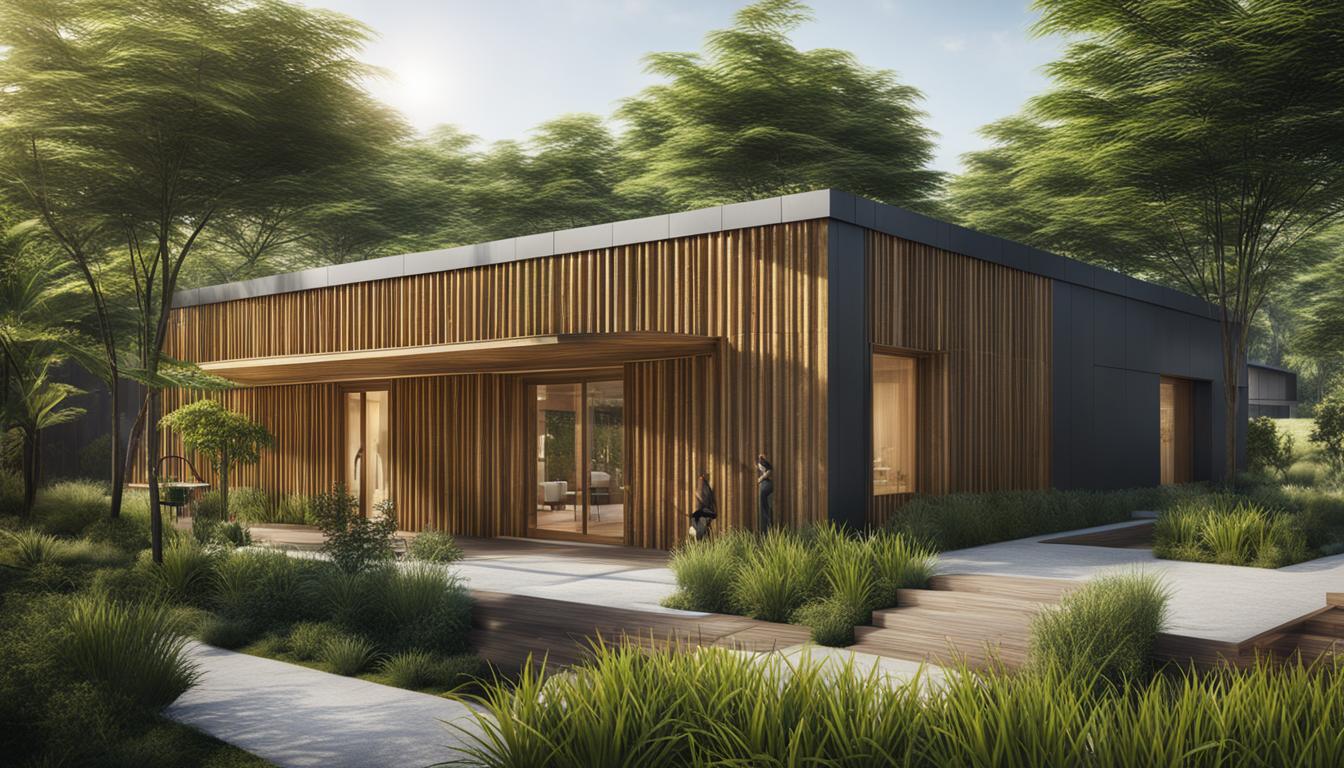In today’s world, architects, builders, and homeowners are increasingly embracing energy-efficient building designs. With a focus on sustainable practices and eco-friendly construction, these designs prioritize energy efficiency and green materials. From LEED-certified buildings to environmentally conscious architecture, the trend towards sustainable architectural solutions is on the rise.
Energy-efficient design encompasses various elements, including optimizing appliances, insulation, lighting, heating and cooling systems, water heating, and windows. By taking a holistic approach to whole-house systems, energy-efficient buildings can significantly reduce energy consumption and decrease environmental impact.
Key Takeaways:
- Green building and architecture are gaining popularity, driven by a focus on sustainable living.
- Eco-friendly construction emphasizes energy-efficient design and the use of green materials.
- LEED-certified buildings exemplify environmentally conscious architecture.
- Sustainable architectural solutions include optimizing appliances, insulation, lighting, heating and cooling systems, water heating, and windows.
- Sustainable urban design plays a vital role in creating energy-efficient buildings.
Benefits of Energy-Efficient Buildings
Energy-efficient buildings offer numerous benefits. They not only contribute to a greener environment but also provide significant cost savings and financial advantages for building owners. Let’s explore some of the key benefits of energy-efficient buildings:
1. Cost Savings
One of the most notable benefits of energy-efficient buildings is the potential for cost savings. By implementing energy-saving measures, such as efficient heating, cooling, and lighting systems, these buildings can significantly reduce energy consumption and lower utility bills. For commercial buildings, this can result in substantial operating expense savings.
2. Return on Investment
Energy-efficient buildings offer a better return on investment compared to traditional buildings. By reducing energy demand and maintenance needs, these buildings can enhance their overall value. Additionally, energy-efficient buildings have increased market desirability, attracting tenants and buyers who prioritize sustainability.
3. Special Programs and Incentives
Various programs, rebates, and incentives are available to support energy efficiency efforts in buildings. These programs aim to encourage the adoption of sustainable practices and offer financial advantages to building owners. By taking advantage of these special programs and incentives, building owners can further reduce their upfront costs and accelerate the return on their investment.
4. Greenhouse Gas Reduction
Energy-efficient buildings play a crucial role in reducing greenhouse gas emissions. By minimizing energy consumption and utilizing renewable energy sources, these buildings contribute to a healthier environment. The reduction in greenhouse gas emissions helps combat climate change and improve air quality.
To illustrate the potential benefits of energy-efficient buildings, consider the following table:
| Benefits | Description |
|---|---|
| Cost Savings | Energy-efficient buildings can lead to significant cost savings on energy bills, reducing operating expenses for commercial buildings. |
| Return on Investment | Building energy efficiency can result in a better return on investment by reducing maintenance needs and increasing property value. |
| Special Programs and Incentives | Various programs, rebates, and incentives are available to support energy efficiency efforts, offering financial advantages to building owners. |
| Greenhouse Gas Reduction | Energy-efficient buildings help reduce greenhouse gas emissions, contributing to a healthier environment. |
By embracing energy efficiency in building design and operation, we can unlock a range of benefits, including cost savings, financial advantages, and a positive impact on the environment. The next section will delve into the key features of energy-efficient commercial buildings.
Key Features of Energy-Efficient Commercial Buildings
The design and features of energy-efficient commercial buildings play a crucial role in achieving optimal energy savings. By incorporating various elements and technologies, these buildings can significantly minimize energy consumption and contribute to a greener future.
1. Proximity to Public Transit
One key feature of energy-efficient building design is proximity to public transit. Strategically locating commercial buildings near public transportation options reduces the reliance on cars, minimizing fuel consumption and emissions. This not only benefits the environment but also promotes sustainable commuting practices.
2. Building Orientation and Natural Light
Building orientation is another essential aspect that contributes to energy efficiency. By considering the angle and position of the building in relation to the sun’s path, architects can maximize the use of natural light and reduce the need for artificial lighting. This lowers electricity consumption and enhances the overall energy performance of the building.
3. Retrofitting and Future Retrofitting
Energ-efficient commercial buildings can be retrofitted to improve their energy performance. Retrofitting involves making modifications to existing structures to enhance their energy efficiency. Additionally, designing new buildings with future retrofitting in mind ensures that these structures can be updated with new technologies as they become available, further improving their energy efficiency.
4. Building Size Optimization
Optimizing building size is another crucial factor in energy-efficient designs. Constructing the appropriate size of the building ensures minimized material usage and reduced energy demands for heating, cooling, and overall operations. Efficient space planning and thoughtful design can result in significant energy savings.
5. Meeting Energy Efficiency Standards
Adhering to established energy efficiency standards is essential for creating sustainable commercial buildings. Compliance with building codes and regulations ensures that the structures are designed and built to meet specific energy efficiency requirements, resulting in lower energy consumption and reduced environmental impact.
6. Insulation and Energy-Efficient Windows
Effective insulation plays a critical role in energy-efficient building design. Properly insulated structures minimize heat transfer, reducing the need for excessive heating or cooling. Additionally, using energy-efficient windows with low U-factors and high solar heat gain coefficients helps to preserve indoor temperatures, further reducing energy consumption.
7. Solar Panels and High-Efficiency HVAC Systems
The integration of renewable energy sources, such as solar panels, is becoming increasingly common in energy-efficient commercial buildings. Solar panels convert sunlight into electricity, providing a clean and renewable energy source. High-efficiency HVAC (Heating, Ventilation, and Air Conditioning) systems optimize energy consumption for heating and cooling, contributing to overall energy savings.
8. Air Filters, Sealants, and Vents Placement
Regular maintenance of air filters and clean air ducts is essential for ensuring optimal indoor air quality while promoting energy efficiency. Additionally, the use of sealants to prevent air leaks and strategic placement of vents for proper air circulation enhances energy performance and overall building comfort.
9. Programmable Thermostats, LED Lights, and Energy Star Appliances
Energy-efficient commercial buildings incorporate various technologies such as programmable thermostats, LED lights, and Energy Star-rated appliances. Programmable thermostats allow for customized temperature settings, reducing unnecessary energy consumption. LED lights offer significant energy savings compared to traditional lighting sources. Energy Star-rated appliances are designed to consume less energy without compromising performance.
10. Energy-Efficient Water Heaters
Energy-efficient water heaters are another important component of energy-efficient commercial buildings. These systems employ innovative technologies to heat water more efficiently, reducing energy consumption and lowering utility costs.

By taking advantage of financial incentives, investing in energy-efficient building practices, and earning green building certifications, building owners can improve their return on investment and contribute to a more sustainable future.
Environmental Benefits of Energy-Efficient Buildings
Energy-efficient buildings play a crucial role in addressing climate change and reducing environmental impact. By prioritizing energy efficiency, these buildings contribute to lower greenhouse gas emissions, combatting global warming, and creating a healthier, more sustainable environment.
One of the key benefits of energy-efficient buildings is the reduction in energy consumption. By incorporating energy-efficient design principles and utilizing efficient equipment and technologies, these buildings significantly decrease the need for energy, thus minimizing the associated carbon emissions.
The use of energy-efficient building materials, such as insulation and energy-efficient windows, helps regulate indoor temperatures, reducing the reliance on mechanical heating and cooling systems. This not only saves energy but also minimizes the environmental impact associated with the production and use of fossil fuels for energy generation.
Furthermore, energy-efficient buildings contribute to improved indoor air quality by minimizing air pollution. By using efficient HVAC systems, air filters, and proper ventilation techniques, these buildings ensure a healthier environment for occupants, reducing the risk of respiratory diseases and allergies.
“Energy-efficient buildings not only save energy and money but also help combat climate change by reducing greenhouse gas emissions.”
By adopting green building certification guidelines, such as LEED (Leadership in Energy and Environmental Design), builders and designers adhere to stringent energy efficiency standards. This ensures that these buildings are optimized for energy efficiency and contribute to a sustainable future.
Environmental Benefits of Energy-Efficient Buildings:
| Benefits | Description |
|---|---|
| Reduction in greenhouse gas emissions | Energy-efficient buildings minimize carbon emissions, a major contributor to climate change. |
| Improved indoor air quality | Efficient HVAC systems and ventilation reduce pollutants, enhancing occupants’ health and well-being. |
| Reduced reliance on fossil fuels | Energy-efficient buildings require less energy, reducing the need for fossil fuel-generated electricity and heat. |
| Minimized air pollution | Efficient building design and equipment reduce emissions from heating, cooling, and ventilation systems. |
Conclusion
Energy-efficient building designs are a cornerstone of sustainable living and eco-consciousness. These designs play a crucial role in reducing energy consumption and creating a greener world. By incorporating energy-efficient strategies and renewable energy systems, buildings can lower costs and contribute to a more sustainable future.
From residential homes to commercial buildings, the principles of green building and architecture offer endless opportunities to create sustainable, efficient, and environmentally friendly spaces. By embracing energy efficiency, we can reduce our carbon footprint and minimize the impact on our planet. Energy-efficient building designs not only benefit the environment but also enhance the quality of life for occupants, providing comfortable and healthy living and working environments.
As the world increasingly recognizes the importance of sustainable practices, energy-efficient building designs are becoming a standard in the construction industry. Green building and architecture have evolved to include innovative technologies, materials, and design elements that prioritize energy efficiency. By adopting these principles, we can create buildings that harmonize with their surroundings, minimize resource consumption, and promote a more sustainable and resilient future.
Embracing energy-efficient building designs is not just a trend, but a necessary step towards a more sustainable future. By making conscious choices in our construction practices and embracing eco-friendly technologies, we can contribute to sustainable living and foster a greener and healthier planet for generations to come.
FAQ
What are some benefits of energy-efficient buildings?
Energy-efficient buildings offer significant cost savings on energy bills, reduce operating expenses for commercial buildings, increase property value, and contribute to a healthier environment by reducing greenhouse gas emissions.
What are the key features of energy-efficient commercial buildings?
Key features include proximity to public transit, building orientation for natural light optimization, retrofitting existing buildings, designing for future retrofitting, appropriate building size, meeting energy efficiency standards, proper insulation, energy-efficient windows, solar panels, high-efficiency HVAC systems, air filters and clean air ducts, sealants to prevent air leaks, strategic vent placement, programmable thermostats, LED lights, Energy Star appliances, and energy-efficient water heaters.
What is ultra-efficient home design?
Ultra-efficient home design goes beyond basic energy efficiency principles and incorporates renewable energy systems. It integrates passive solar heating and cooling strategies, energy-efficient landscaping, and aims to reduce energy use and meet the remaining energy needs with renewable energy sources. Another approach is to build or remodel to the Passive House standard, which focuses on creating extremely well-insulated and airtight structures with minimal heating and cooling requirements.
Are there financial incentives for energy-efficient buildings?
Yes, many regions offer financial incentives and rebates for energy-efficient buildings. Programs like the Database of State Incentives for Renewables and Efficiency provide information on incentives available in specific areas, including tax credits, rebates, and savings. Energy-efficient buildings also have the potential for a higher return on investment and increased market desirability.
What are some environmental benefits of energy-efficient buildings?
Energy-efficient buildings contribute to lower greenhouse gas emissions, limit carbon emissions, reduce air pollution, and decrease waste, leading to a healthier and more sustainable environment. By reducing energy consumption and decreasing the use of natural resources, energy-efficient buildings combat global warming and contribute to a greener world.
What is the importance of energy-efficient building designs?
Energy-efficient building designs play a crucial role in achieving optimal energy savings, lowering costs, and creating a sustainable and eco-conscious built environment. By implementing energy-efficient strategies and incorporating renewable energy systems, buildings can reduce energy consumption and contribute to a greener world.
Source Links
- https://www.energy.gov/energysaver/ultra-efficient-home-design
- https://www.energy.gov/energysaver/efficient-home-design
- https://aeroseal.com/air-duct-sealing-blog/energy-efficient-building-design/
- Regulatory and Compliance: Pioneering the Future of Saudi Arabia’s Dedicated Cargo Airline - December 21, 2024
- Financial Strategies: Fueling the Growth of Saudi Arabia’s Dedicated Cargo Airline - December 20, 2024
- Operational Excellence: Ensuring Competitive Edge for Saudi Arabia’s Dedicated Cargo Airline - December 19, 2024






